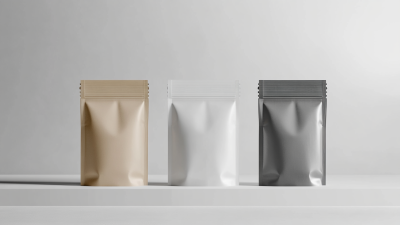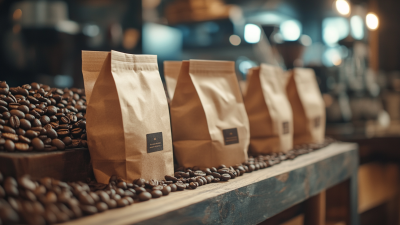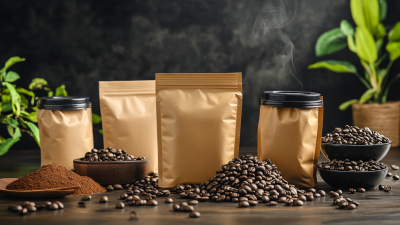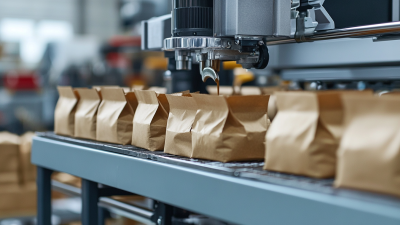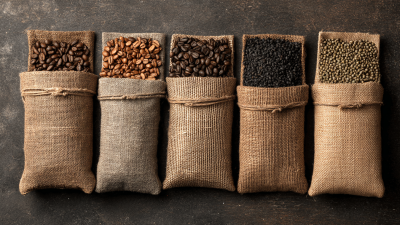- Phone:+86 15218629499
- Phone: +86 15766990063
- E-mail: Yzprinting01@163.com
 In the ever-evolving coffee industry, quality preservation is paramount, and one critical component of this process is the "Coffee Plastic Bag." According to a report by the Specialty Coffee Association, about 40% of coffee's flavor can degrade within a month due to improper storage methods, highlighting the importance of effective packaging. The right Coffee Plastic Bag minimizes exposure to air, moisture, and light, which are known to accelerate staleness and flavor loss.
In the ever-evolving coffee industry, quality preservation is paramount, and one critical component of this process is the "Coffee Plastic Bag." According to a report by the Specialty Coffee Association, about 40% of coffee's flavor can degrade within a month due to improper storage methods, highlighting the importance of effective packaging. The right Coffee Plastic Bag minimizes exposure to air, moisture, and light, which are known to accelerate staleness and flavor loss.
Studies show that coffee stored in high-quality plastic bags can retain its optimal freshness for up to six months compared to only two weeks when using standard packaging. By employing innovative storage solutions, coffee producers can enhance flavor longevity and ensure that their products meet increasing consumer demands for quality and taste. This article delves into the essential role of Coffee Plastic Bags in maintaining coffee integrity, offering valuable tips for industry stakeholders to elevate their quality preservation strategies.
Packaging plays a critical role in maintaining the freshness of coffee, a commodity highly sensitive to environmental factors. The exposure of coffee beans to air, light, moisture, and heat can lead to a significant loss of flavor and aroma. Quality coffee bags, particularly those made from plastic, are designed to provide a barrier against these elements, thereby preserving the beans' inherent qualities for a longer period. These bags often come equipped with one-way valves, allowing gases from the freshly roasted beans to escape without letting in air, further safeguarding the coffee's freshness.
In addition to physical protection, effective packaging facilitates proper storage and transport of coffee. It minimizes the chances of contamination from external odors and substances that could compromise the coffee's delicate profile. When consumers purchase coffee, the integrity of the packaging ensures that they experience the intended flavor and aroma, reflecting the care taken during the roasting process. Thus, in the coffee industry, the choice of packaging is vital, directly impacting customer satisfaction and the overall quality of the coffee experience.
In the coffee industry, the preservation of quality heavily depends on the packaging used, with coffee plastic bags taking center stage. These bags are typically composed of multiple layers that provide an effective barrier against moisture, oxygen, and light, all of which can significantly degrade the flavor and freshness of coffee beans. The materials used in these bags are specifically chosen to withstand external elements while maintaining the integrity of the coffee inside, making them essential for roasters and consumers alike.
Understanding the environmental impact of packaging choices is crucial, especially in light of ongoing discussions about single-use plastics. As the coffee industry continues to evolve, there is a growing emphasis on balancing quality preservation with sustainability. Innovations in biodegradable materials and reusable packaging options are being explored, highlighting the industry's shift toward more sustainable practices. This ongoing research underscores the importance of packaging not just for quality control, but also for addressing consumer concerns about plastic waste and promoting environmentally responsible choices in the coffee supply chain.
 Coffee plastic bags play a crucial role in preserving the quality of coffee by offering protection against oxygen and moisture, which are two of the main factors that lead to flavor degradation. Traditional packaging methods often lacked the necessary barriers, allowing these elements to compromise the freshness and aroma of the coffee within. With advancements in packaging technology, modern coffee bags are now designed to effectively seal out air and moisture, ensuring that consumers can enjoy the intended taste experience from the moment they brew their coffee.
Coffee plastic bags play a crucial role in preserving the quality of coffee by offering protection against oxygen and moisture, which are two of the main factors that lead to flavor degradation. Traditional packaging methods often lacked the necessary barriers, allowing these elements to compromise the freshness and aroma of the coffee within. With advancements in packaging technology, modern coffee bags are now designed to effectively seal out air and moisture, ensuring that consumers can enjoy the intended taste experience from the moment they brew their coffee.
Recent innovations in the coffee packaging industry have led to the introduction of polyethylene mono-material coffee bags, which not only provide excellent protection against external elements but also enhance sustainability efforts. These innovative bags are engineered with a focus on maintaining the integrity of the coffee beans, allowing them to retain their rich flavors and aromas for extended periods. The implementation of features such as degassing valves further enhances the protective capabilities of these bags, ensuring that volatile compounds are kept intact while preventing oxygen from entering. As a result, consumers benefit from a fresher, more flavorful cup of coffee with every brew.
The choice of packaging plays a crucial role in preserving the quality of coffee, and a comparative analysis of coffee plastic bags versus traditional packaging reveals significant advantages. Traditional methods, such as paper bags or glass jars, while nostalgic, often fail to protect the delicate nuances of aroma and flavor from external elements like air, moisture, and light. This vulnerability can lead to quick deterioration, resulting in a subpar tasting experience.
In contrast, coffee plastic bags—specifically designed for this purpose—offer several critical benefits. They are generally airtight, which helps to shield the coffee from oxygen that can cause staleness. Additionally, many modern plastic bags are equipped with one-way valves, allowing gases from roasted coffee to escape while preventing outside air from entering. This feature not only extends the shelf life but also better maintains the coffee's freshness, offering a consistent quality that is often missed with traditional alternatives. The effectiveness of coffee plastic bags underscores their essential role in quality preservation within the coffee industry.

Innovations in coffee bag design have significantly transformed how coffee is preserved and enjoyed. Traditionally, coffee beans were stored in simple paper or fabric bags, which often led to rapid degradation of freshness and flavor due to exposure to air, light, and moisture. However, contemporary advancements have ushered in the use of multi-layered plastic bags that incorporate barrier technologies, effectively sealing in essential oils and preventing oxidization. This enhanced packaging not only extends shelf life but also ensures that coffee retains its rich aroma and nuanced flavors.
Another remarkable innovation in coffee bag design is the integration of one-way valve technology. These specially designed valves allow gas produced during the roasting process to escape without letting air in, maintaining the ideal environment within the bag. This innovation helps to prevent the bags from bursting due to pressure while simultaneously keeping external elements at bay that could compromise the coffee's integrity. As a result, roasters can deliver fresher, higher-quality coffee to consumers, revolutionizing the experience from farm to cup.
| Feature | Description | Impact on Quality |
|---|---|---|
| Barrier Properties | Multi-layer plastic bags that prevent moisture, oxygen, and light from entering. | Helps maintain the freshness and flavor profile of coffee. |
| Degassing Valve | One-way valves that allow gases released by fresh coffee to escape without letting air in. | Prevents bag bursting and preserves aroma and flavor. |
| Recyclability | Bags made from recyclable materials that minimize environmental impact. | Encourages sustainable practices in the coffee industry. |
| Size Variability | Available in different sizes to cater to varying consumer needs. | Reduces waste and ensures the right amount of coffee is consumed. |
| Print Quality | High-quality printing for branding and product information. | Attracts consumers and influences purchasing decisions. |

